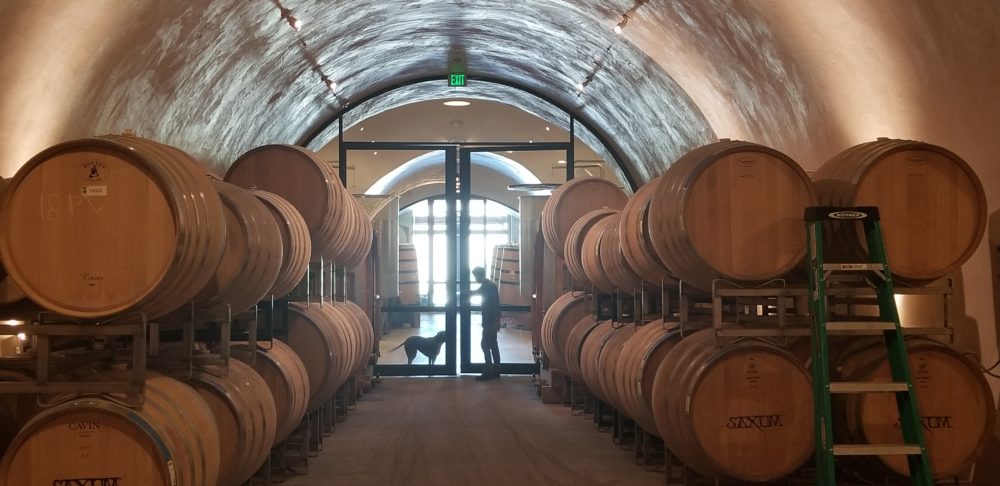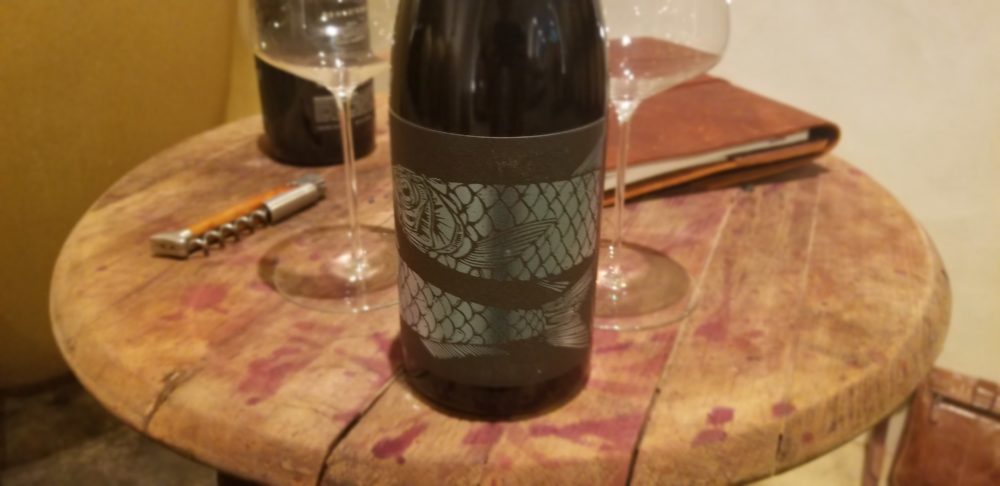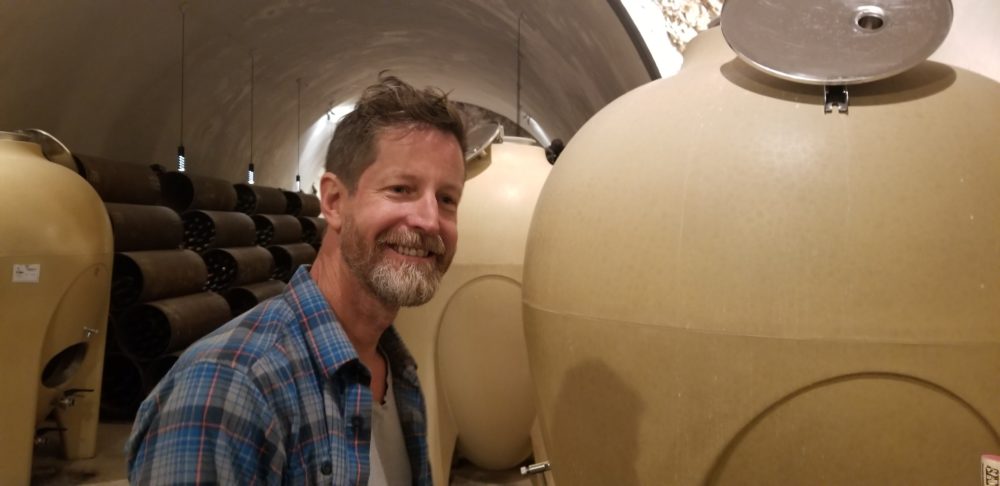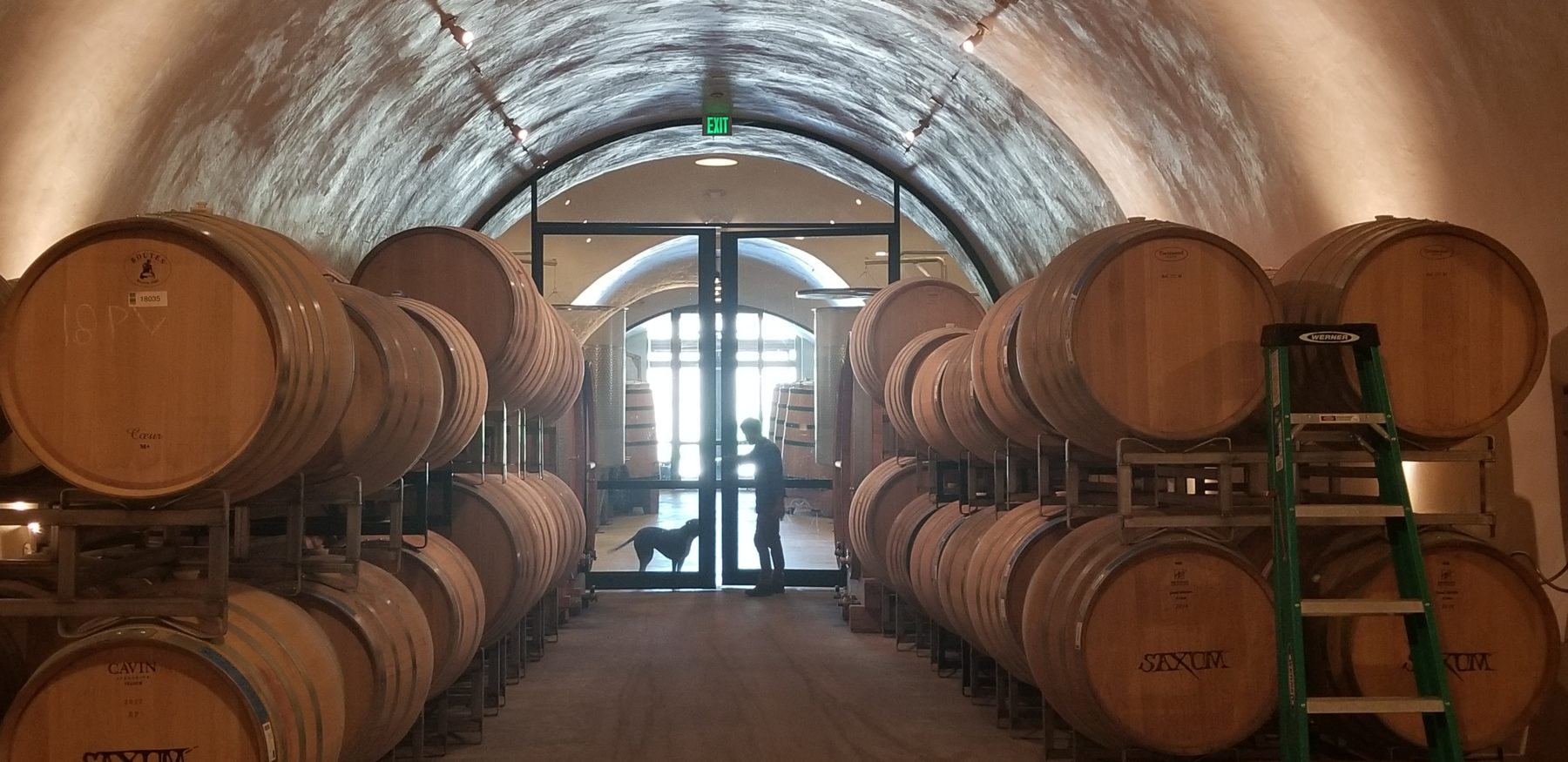
Dust Kills.
Or so says the first sign I see as I enter the Saxum Vineyards estate in Paso Robles. A few days before I visit, I receive an email from an employee asking that I please drive 5 mph on my way in as I head up to the winery. The driveway is feet from meticulous vineyards rows of vines already bearing young, tender fruit, and the ground is dry and powdery. (If you haven’t driven 5 mph of late, it’s worth doing, even for just a short while. It’s a gentle, Zen-like pace and a nice lesson in slowing down).
When I arrive at the winery, I’m greeted by Justin Smith and his dog, Luna, a sweet rescue Pit Bull mix. The winery is an airy, modern building flooded with natural night that illumines, in the distance, caves carved into an estate hillside. Before entering the barrel room, one passes through a lounge area possessing the bohemian mood of a ’70s-era Laurel Canyon living room with Moroccan influences. A formidable vinyl collection and impressive stereo set-up complete the space, giving it a laid-back, welcoming vibe. Smith, fit and youthful at 49, appears jovial and excited about his new project – Downstream Wines – a collaboration between Smith, Sasha Verhage and Philippe Cambie.
Cambie is a highly-regarded consultant from Southern Rhône, with clients worldwide. Considered a master blender, Cambie brings his nearly savant-like talent to Downstream. Verhage is the conduit that brought Smith and Cambie together in 2015, and his love of Southern Rhônes precedes him. “Sasha put us together,” Smith says. “He told me that Cambie wanted to work me, but he wanted to do something Zinfandel-based. I loved that because it’s kind of California’s heritage variety, and I think he sees a lot of parallels between Zinfandel and the Grenaches he works with so much. He didn’t want to repeat what he does in Chateauneuf du Pape, and wanted to put a California twist on things. So we tracked down some old Dusi Zinfandel.” The Dusi Vineyard is among one of Paso’s most historic sites, farmed since 1945 by the Dusi family.
“Philippe likes to come through right when things are done with malo, usually in early spring and before we’ve blended up our wines, when things are still in individual lots. We put about thirty-two different lots in front of him in groups of four – four Zinfandel lots, four Mataro lots, and so on. He writes his notes down, and then just says, ‘I want 600 L of this, and 400 L of that and 200 L of that.’” Smith says Cambie’s decisions are definitive, and he doesn’t change his mind. When Smith and Verhage tasted the final 2016 – their debut release – Smith says they looked at each other and said “How did he do that?!” Smith describes it as “delicious and ready-to-go.” And indeed it is. Smith pours me the 2016 Downstream: a blend of 76% Zinfandel, 8% Syrah, 6% Mataro, 6% Petite Sirah and 4% Tempranillo, raised in 400 L neutral wood puncheons.
Drinking this wine proves to be an emotional experience for me. I have long revered Zinfandel, and to see it elevated to this degree, as winemakers like Paul Draper (Ridge), Mike Officer (Carlisle) and Tegan Passalacqua (Turley) have done, is poignant. There’s a pronounced vitality and verve to this wine. It’s fleshy and generous, but an underlying strand of salinity keeps it fresh and definitive on the palate. At the back of the palate, and just before the finish, this wine broadens beautifully, highlighting the wine’s spicy and savory notes, along with its high-toned blue fruit notes. It’s a stellar wine.
I find myself wondering how Cambie can blend up such an ineffable beauty, and Smith says, “He writes it down and then drops the mic and off he goes. I don’t make wine specifically for him. I don’t know how his brain works. He finds a way to blend them up that’s approachable. He wants them to be delicious and pleasurable.” The Dusi Vineyard Zinfandel announces itself pretty much from the get-go on the 2016 Downstream. “We did the Dusi Zin whole-cluster,” Smith tells me, “which gets all that spice coming out of the stems. I think that’s unique for a Zinfandel – that cool pepper spice, which we loved in the 2016 vintage.”
The packaging presentation of the 2016 Downstream wine is formidable and delicate all at once. Each order includes three 750 ml bottles and one magnum, presented in a large, wood box with the Downstream artwork prevalent throughout the packaging. Artist Joe Kalionzes, a local Paso Robles Spanish and Art teacher, designed the nearly ethereal packaging. The debut collection is just under $1,000.00 and comes to about $200.00 a bottle.

I am glad the Downstream wines are priced at $200.00 a bottle. Why shouldn’t a bottle that is largely Zinfandel or Grenache from the United States command that price? If extremely well-farmed and well-made, shouldn’t these wines merit as much as a fine Cabernet Sauvignon or Pinot Noir? There’s long been a kind of grape racism that exists among the trade. Unfortunately, certain buyers and sommeliers have tried to pass this perception along to the consumer. It’s silly, really, that people would place a value judgment on a product of nature. It’s like me saying, “Passion fruit juice is really where it’s at. If you like mango juice, then you’re a loser. You don’t have good taste.” Value judgments like these are arbitrary in the end.
Especially guilty of these types of value judgments are a particular brand of “influencer” (what an awful word) and “gatekeeper” (thankfully, these change nearly every year) who hold Old World wines, particularly Burgundy, in such high esteem that they’d rather disparage other varieties, and domestic wines in general, than step outside of their comfort zone to try something new. When they’re trying to impress colleagues, they’ll show up to an event with an expensive Burgundy. Wouldn’t it be refreshing to see a gatekeeper arrive at a dinner party or wine tasting with a Zinfandel from California’s Central Coast? Of course, that kind of move takes confidence.
When I ask Smith about the Downstream name, he says, “We’d been thinking about what to call it for forever, but nothing was sticking. And then I had a dream: I was driving down the 101, past Atascadero, about to get off the freeway to go to In-N-Out Burger, and it hit me.” In his dream, he exclaimed, as he does now recounting it, “Downstream! We’re going to call it Downstream! I can’t wait to call Sasha and tell him that I found the perfect name: Downstream!” When he woke up, he felt it was the perfect name. And though he says the name didn’t hold a lot of meaning immediately after the dream, Smith now sees parallels between the name and his creative intentions. Smith’s portions of the proceeds from Downstream will be donated entirely to local charities. “I’ll be sending that money downstream,” he says. He thinks his subconscious was already aware of hidden meanings in the Downstream name before his conscious mind caught up. He quotes a Beatles lyric from “Tomorrow Never Knows” as another possible inspiration for the name: Turn off your mind, relax and float downstream.
The way Cambie create blends has caused Smith to look at his vineyard sources through new eyes. “I don’t spend a lot of time on the crafting of my blends. For me, it’s about the vineyard sources. And we have barrel lots that best exemplify the vineyards I work with, like James Berry. My wines are not so much crafted as blends as they are crafted by the vineyards themselves.” Cambie, Smith says, is less concerned with the vineyard sources. Instead, he assesses the various lots presented to him with regard to how well they’ll go together. Smith appreciates the purity of an approach unfettered by value judgments about a vineyard that one might expect to perform in a certain manner. “It frees you up in a way,” he says.

Smith shares Cambie’s analogy for creating a blend, a talent Smith regards as Cambie’s profound gift. “Philippe says, ‘it’s as simple as making a sandwich. You taste through, and one wine is the bread. The other is the meat. One is the mustard, and you want just a little bit of mustard. This wine is the lettuce and, this one, the tomatoes. And this one is the butter. And this one is the butter, too, so you don’t need both of these. You’re not going to put five pieces of bread together, even if you like bread, because five slices of bread does not make a sandwich.’ ” As he shares this analogy, Smith’s eyes brighten; he seems genuinely moved by this collaborative project.
His own Saxum Vineyards label has been wildly successful, a critical and consumer darling. I wonder aloud if Smith feels pressure to see the Downstream collaboration succeed as much as Saxum has. “It’s kind of the opposite. I think of Downstream as Philippe’s wine. This is a wine I can sit down and enjoy at the table while wondering about what he was thinking when he created the blend.” Smith admits that it’s hard to enjoy his own wines in that same way, as he’s always tasting them critically. “I’ll taste my wines and think, ‘Oh, I shouldn’t have done that, or I should have done this differently.’ With this project, it’s more fun and less pressure.”
We next taste the 2017 Downstream, which is quite different from the 2016. It shares the ’16’s seamless texture, structure and salinity, but departs from there with more Grenache than Zinfandel in the finished blend. It’s another arresting effort, with dried citrus rind and wild plum cherry notes nearly jumping out of the glass. An energetic wine with plenty of tension, it still delivers great pleasure and balance. If these young Downstream wines have a hallmark, it’s their structural integrity, generosity of fruit and a pronounced saline signature. The 2018 is finished but still in barrel. Yet again, Cambie has come up with an entirely different, yet equally lively blend. The three Downstream wines I’ve just tasted have about them an unpredictability. Their enigmatic nature stems from the pleasure principle that is present across vintages and the balance with which that pleasure is delivered. These wines prove that you can experience deep hedonistic pleasure as well as linearity and delineation in a wine.
Currently only one Downstream wine will be released each vintage, and Smith predicts it will remain this way. And when I ask if fruit will ever be sourced from other parts of California, Smith is quick to point out that he hopes Downstream always finds its provenance in the soils of Paso Robles. “My whole thing is this little pocket of Paso. All of our vineyards are near here. I grew up here and I have a lot of pride in what can be done here. A lot of my impetus behind making wine is to showcase Paso.”

As we wrap up our visit, Smith pours me a Gewürztraminer made by his son Colin, 22, with guidance from Smith’s father and no assistance from Smith himself. It’s a refreshing, bright white, sourced from the coastal Stolo Vineyard, and we sip it as Smith talks about his other creative undertakings. “I’m fermenting hot sauce right now – gardened specifically for the various peppers that go into fermented hot sauce – and we’ll bottle that. And we’ve got bees that we tend for honey. I hunt wild boar and deer and make sausage. I realized I like to make things to share with people.”
Colin Smith has made a lovely (albeit not for sale), delicious wine. The grape doesn’t fall far from the vine in this family. Smith is visibly proud of his son’s wine, and while he sends me home with what’s left of the Downstream wines we’ve opened, he’s quick to grab the Gewürztraminer for himself as he walks me out. “My wife needs to taste this. It’s pretty good!”

